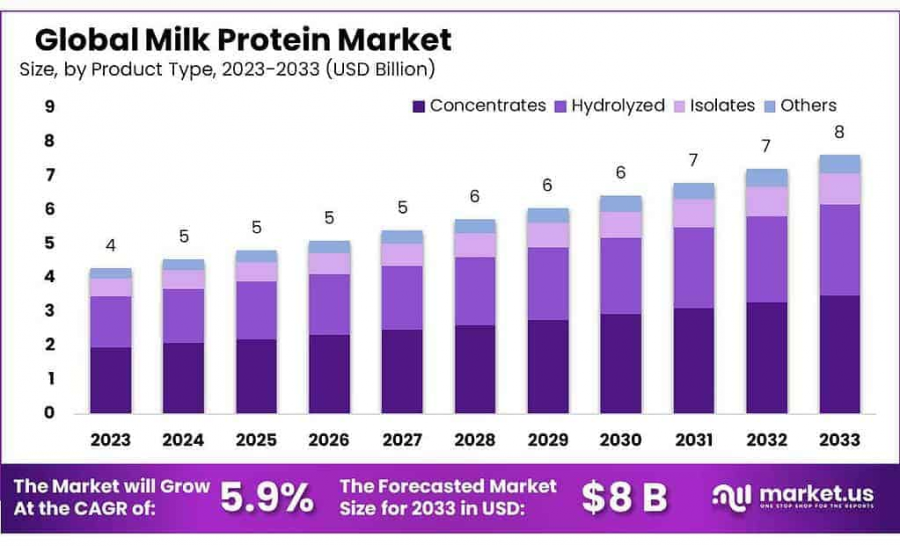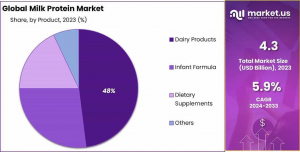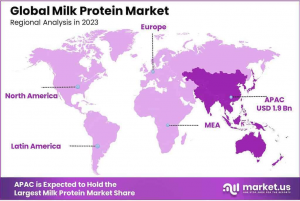
Milk Protein Market To Reach USD 8.0 Billion by 2033 at 5.9% CAGR
The milk Protein Market size is expected to be worth around USD 8 billion by 2033, from USD 4 billion in 2023, growing at a CAGR of 5.9% from 2023 to 2033.
NEW YORK, NY, UNITED STATES, January 31, 2025 /EINPresswire.com/ -- The global Milk Protein Market has emerged as a critical segment within the broader dairy industry, driven by the increasing demand for high-quality protein sources across various applications, including food and beverage, sports nutrition, infant formula, and pharmaceuticals. Milk proteins, primarily consisting of casein and whey protein, are valued for their nutritional benefits, functional properties, and versatility in product formulation. The market has witnessed steady growth in recent years, fueled by rising health consciousness, urbanization, and the growing popularity of protein-rich diets. Additionally, the expanding middle-class population in emerging economies and the increasing adoption of Western dietary patterns have further bolstered demand.
The milk protein market is characterized by a competitive landscape with key players focusing on innovation, product diversification, and strategic partnerships to strengthen their market position. Technological advancements in protein extraction and processing have enabled manufacturers to produce high-purity milk protein isolates and concentrates, catering to the evolving needs of consumers and industries. Geographically, North America and Europe dominate the market due to high consumer awareness and established dairy industries. However, the Asia-Pacific region is expected to witness the fastest growth, driven by rising disposable incomes, urbanization, and increasing demand for functional foods and beverages.
Several factors are driving the growth of the global milk protein market. The growing trend of health and wellness, coupled with the rising prevalence of lifestyle diseases, has led to increased consumption of protein-based products. The sports nutrition and fitness industry has also played a significant role in boosting demand, as milk proteins are widely recognized for their muscle-building and recovery properties. Furthermore, the infant formula segment remains a key driver, particularly in regions with high birth rates and increasing awareness of the nutritional benefits of milk proteins for early childhood development.
Market.us proffers a complete understanding of the Milk Protein Market [Snapshot - Global Market Size, Largest Segment, Fastest Growth, and Growth Rate in 5.9%] in its latest research report. It also offers a detailed analysis of the global Milk Protein market that considers market dynamics such as segmentation, geographic expansion, competitive environment, and many other key elements. The Milk Protein Market data reports also provide a 3-year pre-historic forecast (up to 2033) for the sector and include data on socio-economic data of global.
Global Milk Protein Market research report contains product types (By Product Type(Concentrates, Hydrolyzed, Isolates, Others), By Form(Powder, Liquid, Paste/Spreadable, Others), By Application(Dairy Products, Infant Formula, Dietary Supplements, Others), By End-use(Food And Beverages, Nutraceuticals And Dietary Supplements, Pharmaceutical, Cosmetics And Personal Care, Pet Care Industry, Others)), and companies (Amco Protein, Arla Foods, Fonterra Co-operative Group Limited, Frieslandcampina, Glanbia PLC, Groupe Lactalis S.A., Havero Hoogwewt, Hoogwegt Groep B.V., Kerry Group plc, Koninklijke FrieslandCampina N.V., Lactalis, Sachsenmilch Leppersdorf GmbH, Saputo Inc). Furthermore, with regional analysis, all logical and factual summaries about the Milk Protein Market 2023, CAGR, production volume, sales, and revenue.
Key Takeaways
• Market Projection: The milk Protein Market is set to reach USD 8 billion by 2033, with a 5.9% CAGR from 2023.
• Product Type Dominance: Concentrates hold the largest market share (45.8% in 2023), followed by hydrolyzed and isolates.
• Form Preference: Powdered milk proteins dominate the market (50.5% in 2023), owing to their convenience and versatility.
• Application Usage: Dairy products lead in the application (48.9% in 2023), emphasizing the importance of milk proteins in enhancing texture and nutritional value.
• End-use Utilization: Food & beverages account for the highest market share (41.8% in 2023), followed by nutraceuticals & dietary supplements.
• Regional Insights: Asia Pacific leads with a 45% market share, followed by North America and Europe, driven by health trends and technological advancements.
➤ 𝐒𝐚𝐦𝐩𝐥𝐞 𝐑𝐞𝐩𝐨𝐫𝐭 𝐑𝐞𝐪𝐮𝐞𝐬𝐭: 𝐔𝐧𝐥𝐨𝐜𝐤 𝐕𝐚𝐥𝐮𝐚𝐛𝐥𝐞 𝐈𝐧𝐬𝐢𝐠𝐡𝐭𝐬 𝐟𝐨𝐫 𝐘𝐨𝐮𝐫 𝐁𝐮𝐬𝐢𝐧𝐞𝐬𝐬: https://market.us/report/milk-protein-market/request-sample/
The TOP Key Market Players Listed in the report with their sales, revenues, and strategies are:
• Amco Protein
• Arla Foods
• Fonterra Co-operative Group Limited
• Frieslandcampina
• Glanbia PLC
• Groupe Lactalis S.A.
• Havero Hoogwewt
• Hoogwegt Groep B.V.
• Kerry Group plc
• Koninklijke FrieslandCampina N.V.
• Lactalis
• Sachsenmilch Leppersdorf GmbH
• Saputo Inc.
➤ 𝐁𝐮𝐲 𝐍𝐨𝐰 𝐭𝐡𝐢𝐬 𝐏𝐫𝐞𝐦𝐢𝐮𝐦 𝐑𝐞𝐩𝐨𝐫𝐭 𝐭𝐨 𝐆𝐫𝐨𝐰 𝐲𝐨𝐮𝐫 𝐁𝐮𝐬𝐢𝐧𝐞𝐬𝐬: https://market.us/purchase-report/?report_id=14200
Milk Protein Market Segmentation: Research Scope
By Product Type
• Concentrates
• Hydrolyzed
• Isolates
• Others
By Form
• Powder
• Liquid
• Paste/Spreadable
• Others
By Application
• Dairy Products
• Infant Formula
• Dietary Supplements
• Others
By End-use
• Food & Beverages
• Nutraceuticals & Dietary Supplements
• Pharmaceutical
• Cosmetics & Personal Care
• Pet Care Industry
• Others
Latest Update: Which Industry Will Boom In the Future? and How big is the Milk Protein Industry?
Milk Protein Market Dynamics:
This section deals with understanding the Milk Protein Market drivers, advantages, opportunities, restraints, and challenges. All of this is discussed in the following sections:
- Increase in Sales Revenue
- Increased Demand from Developing Regions
- Rise in Popularity
- R&D Efforts
- Product Innovation and Offerings
- Higher Cost
Segmentation 3: Geographic regions
- North America (U.S. and Canada)
- Europe (Germany, United Kingdom, France, Italy, Spain, Russia, and Others)
- Asia Pacific (China, India, South Korea, Indonesia, Australia, and Others)
- Latin America (Brazil, Mexico)
- the Middle East and Africa
Highlights of the Report
#1. This report comprehensively explains customer behavior and growth patterns in the Milk Protein market.
#2. The report sheds light on the lucrative business prospects of the Milk Protein market
#3. The readers will gain an insight into the upcoming products and related innovations in the Milk Protein market
#4. The report provides details about the key strategic initiatives adopted by the key players functioning in the Milk Protein market
#5. The authors of the Milk Protein report have scrutinized the segments considering their profitability, market demand, sales revenue, production, and growth potential
#6. In the geographical analysis, the Milk Protein report examines the current market developments in various regions and countries
Key questions answered in this report:
1. What Industry Is In High Demand?
2. What is Milk Protein?
3. What is the expected market size of the Milk Protein market in 2024?
4. What are the applications of Milk Protein?
5. What is the share of the top 5 players in the Global Milk Protein Market?
6. How much is the Global Milk Protein Market worth?
7. What segments does the Milk Protein Market cover?
Recent Trends in the Milk Protein Market
• In recent years, the United States has seen a significant increase in demand for prototypes. Additive manufacturing has become more popular for high-volume production.
• Market participants participate actively in expanding the range and applications of Milk Protein. Technology is rapidly improving. As such, Milk Protein focuses on streamlining pre and post-production.
Lawrence John
Prudour
+91 91308 55334
Lawrence@prudour.com
Distribution channels: Food & Beverage Industry
Legal Disclaimer:
EIN Presswire provides this news content "as is" without warranty of any kind. We do not accept any responsibility or liability for the accuracy, content, images, videos, licenses, completeness, legality, or reliability of the information contained in this article. If you have any complaints or copyright issues related to this article, kindly contact the author above.
Submit your press release


